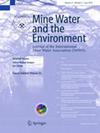多层连续模式模型(MINC)用于模拟煤矿地区的被动物料运输:本文针对西博尼亚半岛的研究
IF 2.1
4区 环境科学与生态学
Q3 WATER RESOURCES
引用次数: 0
摘要
摘要本文测试了多重交互连续体方法(MINC)在扰动采煤后区域反应性物质输运模拟中的适用性。据作者所知,尽管这种方法在其他环境领域取得了相对的成功,但尚未在这种采矿环境中采用。为此,利用TOUGHREACT软件建立了ibbenb本文章由计算机程序翻译,如有差异,请以英文原文为准。
Ein multiples interaktives Kontinuumsmodell (MINC) zur Simulation des reaktiven Stofftransports in einem Bergbaufolgegebiet: Eine Fallstudie über das Ibbenbürener Westfeld
Abstract We tested the suitability of the multiple interactive continua approach (MINC) to simulate reactive mass transport in a disturbed post-mining coal zone. To the authors’ knowledge, this approach has not been employed in such mining settings despite its relative success in other environmental fields. To this end, TOUGHREACT software was used to set up a MINC model of the unsaturated overburden of the Ibbenbüren Westfield. With it, we examined and evaluated water–rock interactions in both the fractured and porous continua as the main driver of elevated hydrogen, iron, sulfate, and chloride concentrations in the coal mine groundwater. Long and seasonal geochemical signatures were obtained by formulating and applying a five-stage modelling process that depicts the mining history of the area. The simulation results agree well with the concentrations and discharge trends measured in the mine drainage. Oxygen and meteoric water flow through the fractured continuum, leading to a high and steady release of hydrogen, iron, and sulfate ions derived from pyrite oxidation in the matrix continua closest to the fractures. Likewise, high chloride concentrations resulted from the mixing and gradual release of relatively immobile solutes in the matrix as they interacted with percolating water in the fracture. In both cases, the use of a multiple continua approach was essential to resolve sharp gradients for advection and faster kinetic reactions, while reducing the model’s dependence on block size for diffusive transport at the fracture–matrix interface. The model further allows for the calculation and analysis of solute exchange and transport in the unsaturated overburden resulting from rebound and imbibition processes, something pioneering when compared to other models in the field.
求助全文
通过发布文献求助,成功后即可免费获取论文全文。
去求助
来源期刊

Mine Water and the Environment
WATER RESOURCES-
CiteScore
5.00
自引率
14.30%
发文量
62
审稿时长
3 months
期刊介绍:
Mine Water and the Environment welcomes original contributions that address either technical questions or practical issues related to the evaluation, prediction, prevention, or control of water problems at mining operations or their impact on the environment. The journal and its audience is interdisciplinary. Manuscripts should convey new technical information and be of potential interest to researchers and/or practitioners in this field. Laboratory and field experiments, modelling efforts, studies of relevant field sites, technical evaluations of new technology, and engineering applications are all appropriate.
 求助内容:
求助内容: 应助结果提醒方式:
应助结果提醒方式:


